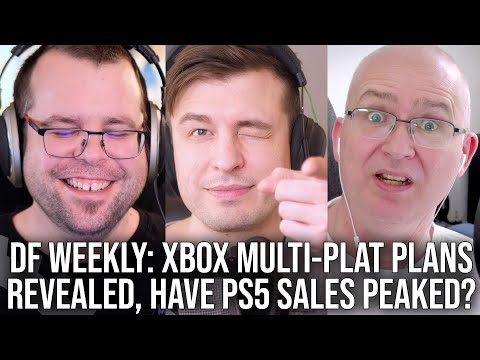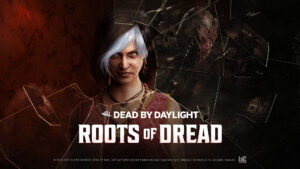In this week’s DF Direct Weekly, the Digital Foundry Team shares their thoughts on the Xbox business update podcast and attempts to fathom strategy from the PlayStation team in the wake of some ominous announcements that resulted in a 10 percentage point dip in Sony’s share price. The bottom line looks stark and very straightforward: the audience for PlayStation and Xbox consoles is not increasing gen-on-gen, while the costs of making games to service that audience is increasing dramatically. Something has to change.
Let’s deal with the Xbox business update first. My take on this is that Phil Spencer and his team really want to take a multi-platform strategy forward, and it’s the obvious, logical solution to addressing the problem of the limit in total addressable audience. Not only that, with its ownership of Minecraft and now Activision-Blizzard-King, it’s already one of the largest multi-platform publishers in the market. I can well imagine that the likes of Satya Nadella can’t quite fathom why Microsoft is limiting its audience in the name of a legacy console model that seemingly isn’t working for Xbox any more.
However, the pitfalls are obvious. Why buy an Xbox console if you can buy a PlayStation and get access to the next games from both platform holders? This concept of exclusivity as ‘specialness’ clearly resounds with the console audience, and I would imagine that the Xbox team spent a great deal of time honing its message for the business update because if the rumours were left unchecked, we could have been looking at another PR disaster on the level of the Xbox One debacle from 2013. On a more practical level, Microsoft does need to continue to make its consoles attractive, even in the wake of its ‘every screen is an Xbox’ messaging. A mechanism to make console sales attractive is required because – in the face of a less than stellar response from Game Pass PC – a home platform is required on which to focus its drive for subscriptions.
 DF Direct Weekly #150: Xbox Business Update, Sony Financials Reaction – Is The Future Multi-Plat?
DF Direct Weekly #150: Xbox Business Update, Sony Financials Reaction – Is The Future Multi-Plat?
- 0:00:00 Introduction
- 0:02:14 News 01: Microsoft explains multiplatform strategy
- 0:45:50 News 02: Sony: PS5 sales have peaked
- 1:05:22 News 03: Rich ‘downgrades’ from 8K to 4K
- 1:17:15 News 04: Arzette: The Jewel of Faramore released
- 1:23:01 Supporter Q1: Why don’t more games support Dolby Vision and HDR 10+?
- 1:32:41 Supporter Q2: Given the limited power of the consoles, should developers reconsider including performance modes?
- 1:41:16 Supporter Q3: Given Nvidia’s tech lead in GPUs, aren’t they an attractive choice for a next-gen console?
- 1:47:00 Supporter Q4: Can Final Fantasy 7 Rebirth’s image quality issues be fixed with a quick patch, or is there a more fundamental limit?
- 1:53:09 Supporter Q5: Whatever happened to the Vulkan graphics API?
The answer, for now at least? Tentative support for existing, lower profile games to shift over to Nintendo and Sony platforms. Spencer wouldn’t name the games, but at this point everyone seems to be aware that we’re talking about Hi-Fi Rush, Sea of Thieves, Pentiment and Grounded. It’s a mixture of service games that can only benefit from more players, or under-appreciated gems that could find more of an audience on other systems. It’s described as an experiment of sorts, to see how multi-platform could work for Xbox.
However, in an interview with The Verge, Phil Spencer refuses to rule out triple-A juggernauts transitioning to other platforms – and realistically, we should assume that this is a fait accompli. Realistically, it has to happen for Microsoft to escape its current, limited addressable market. Making the likes of Indiana Jones a timed exclusive on Xbox and PC, then PlayStation support a year later is an obvious idea – but perhaps one that the Xbox team feels is too early to float right now.
I have to admit that I remain baffled by the ‘every screen is an Xbox’ message – does this include screens attached to PlayStations? The idea doesn’t work if it’s only selected titles, while the obvious workaround – cloud streaming – appears to have failed to gain enough traction. I can’t help but feel that Microsoft is eyeing Steam’s huge success and wondering how to mirror that, while at the same time still limited by the baggage of legacy console strategy.
The Sony financial reports are similarly challenging in terms of the cap on the audience size, but there are further revelations. The biggest headlines refer to the lack of franchise sequels until at least March 2025 and the idea that PlayStation 5 sales have peaked and will decline going forward. We are in the latter stage of its lifecycle, we are told. Prior strategy in previous generations was simple: lower the cost. We have the new, cost-reduced PlayStation 5, but Sony says that this has only balanced prices as the components have become more expensive to procure. The idea of a $299/£299 PlayStation 5 seems unviable. Regular readers of Digital Foundry may remember our Big Xbox Series S interview, where Microsoft explained why this is why they made the junior Xbox in the first place. The cost per transistor in silicon terms is static, while other components seem to have increased in price too.
The solution appears to be a much more aggressive multi-platform strategy, of course! Xbox is highly unlikely to be a part of the picture, but a more focused commitment to PC seems to be the route forward – with the Helldivers 2 success only serving to underline how a day and date multi-platform release can drastically alter the scale of success of a particularly hot game. While the story-driven titles may still have a time delay in place between PS5 and PC releases, I would expect that to diminish significantly and perhaps disappear entirely in the fullness of time – though the logistics in terms of delivering those PC versions is onerous.
Returning to the Xbox business update, Microsoft seemingly committed to two new pieces of hardware. A handheld seems inevitable at this point, and what we should expect from that in terms of specs rests very much on when Microsoft intends to sell it. I also think that the revised 6nm Xbox Series S and the ‘adorably all-digital’ Xbox Series X are still likely to land later this year – why would Microsoft not deploy a cost-reduced console? However, it’s the idea of new hardware that’s a bigger generational leap than anything seen before that is obviously the headline grabber.
Putting my realist’s hat on for a moment, I would be massively surprised to see a leap larger than that of PS1/N64 to PS2/GameCube but a larger generational leap than any seen before in prior Xbox consoles is certainly viable. However, for the same reason that Sony is unable to cost-reduce PlayStation 5 and for the same reason that Xbox Series S exists at all, we need to be realistic about the nature of this technological leap. The Microsoft FTC leak lays out what we should expect in terms of key innovations from its next generation console and it’s essentially the Nvidia RTX feature-set as we see it today: AI-driven upscaling and frame generation.
If console makers can’t brute-force increased performance and capabilities from more transistors alone, it comes via a combination of hardware and software. If we consider what DLSS 3 is doing, perfectly acceptable results are being delivered by just one pixel out of eight being natively rendered. The question is whether Microsoft partners with AMD or Nvidia to get the job done. Is the S/X console strategy dead? Perhaps, but equally, the way forward may be to reposition the S-level product as the handheld, which would cover two bases. And as for Sony? It’ll be interesting to see if PlayStation 5 Pro does arrive this year – and how much of the AI tech (if any!) we’ll get sooner rather than later.
- SEO Powered Content & PR Distribution. Get Amplified Today.
- PlatoData.Network Vertical Generative Ai. Empower Yourself. Access Here.
- PlatoAiStream. Web3 Intelligence. Knowledge Amplified. Access Here.
- PlatoESG. Carbon, CleanTech, Energy, Environment, Solar, Waste Management. Access Here.
- PlatoHealth. Biotech and Clinical Trials Intelligence. Access Here.
- Source: https://www.eurogamer.net/digitalfoundry-2024-df-weekly-a-multi-platform-future-seems-inevitable-for-microsoft-and-sony?utm_source=feed&utm_medium=rss&utm_campaign=feed
- 01
- 10
- 17
- 2013
- 2025
- 23
- 32
- 41
- 7
- 8k
- a
- About
- acceptable
- access
- addressable
- Addressing
- aggressive
- AI
- All
- alone
- also
- AMD
- an
- and
- Announcements
- Another
- answer
- any
- Anything
- api
- appears
- ARE
- as
- assume
- At
- attempts
- attractive
- audience
- aware
- balanced
- BE
- because
- become
- been
- before
- being
- benefit
- between
- BIG
- bigger
- Biggest
- both
- bottom
- Bottom Line
- business
- but
- buy
- by
- CAN
- Cap
- capabilities
- certainly
- challenging
- change
- choice
- clearly
- click
- Cloud
- combination
- comes
- commitment
- committed
- components
- concept
- Consider
- Console
- Console Sales
- Consoles
- content
- continue
- cookie
- cookies
- cost
- Costs
- could
- cover
- Current
- date
- day
- dead
- deal
- delay
- delivered
- delivering
- deploy
- described
- developers
- digital
- Digital Foundry
- direct
- disappear
- disaster
- DLSS
- does
- doesn
- doing
- don
- done
- dramatically
- drastically
- drive
- e
- Early
- edition
- eight
- enable
- enough
- entirely
- equally
- escape
- Essentially
- even
- Event
- Every
- everyone
- Exclusive
- exclusivity
- existing
- exists
- expect
- expensive
- experiment
- explained
- explains
- Face
- Failed
- false
- FANTASY
- Fathom
- feel
- feels
- Figure
- Final
- Final Fantasy
- Final Fantasy 7 Rebirth
- financial
- financial reports
- financials
- find
- First
- first place
- fixed
- Focus
- focused
- For
- Forward
- Frame
- Franchise
- from
- FTC
- fundamental
- further
- future
- gain
- game
- Game Pass
- Games
- Gaming
- GDPR
- generation.
- generational
- generations
- Get
- given
- going
- graphics
- great
- Grounded
- happen
- happened
- Hardware
- has
- hat
- Have
- headline
- Headlines
- Helldivers
- Helldivers 2
- help
- here
- highly
- his
- holders
- Home
- hot
- How
- How To
- however
- HTTPS
- huge
- i
- idea
- if
- image
- imagine
- in
- include
- Including
- increased
- increasing
- Indiana
- inevitable
- innovations
- intends
- interesting
- Interview
- Is
- isn
- issues
- IT
- ITS
- jewel
- Job
- jones
- jpg
- juggernauts
- just
- Key
- lack
- Land
- larger
- largest
- later
- latest
- Lays
- lead
- leak
- Leap
- least
- left
- legacy
- less
- Level
- lifecycle
- likely
- likes
- LIMIT
- Limited
- limiting
- Line
- ll
- logical
- logistics
- looking
- looks
- made
- make
- makers
- Making
- manage
- March
- Market
- massively
- May
- mechanism
- Message
- messaging
- Microsoft
- Minecraft
- mirror
- model
- modes
- moment
- more
- much
- multiplatform
- my
- name
- natively
- nature
- need
- New
- news
- Next
- Next Games
- Nintendo
- not
- now
- nvidia
- obvious.
- Obviously
- of
- on
- One
- only
- or
- Other
- our
- out
- over
- Ownership
- part
- particularly
- partners
- pass
- Patch
- PC
- Pentiment
- per
- percentage
- perfectly
- performance
- perhaps
- Phil Spencer
- picture
- pieces
- Pixel
- place
- platform
- Platforms
- plato
- plato data intelligence
- platodata
- platogaming
- play
- players
- playstation
- playstation 5
- please
- podcast
- Point
- power
- pr
- practical
- previous
- price
- prices
- prior
- Pro
- Problem
- procure
- Product
- Profile
- ps5
- publishers
- Q1
- quality
- question
- quick
- quite
- rather
- RE
- reaction
- readers
- realistic
- really
- reason
- refer
- regular
- release
- Releases
- remain
- Remember
- rendered
- Reports
- required
- response
- Results
- rich
- right
- Route
- Rule
- rumours
- rush
- s
- sales
- same
- Satya Nadella
- says
- Scale
- Screen
- SEA
- Sea of Thieves
- see
- seem
- seemingly
- seems
- seen
- selected
- sell
- sequels
- Series
- Service
- serving
- settings
- Share
- share price
- Shares
- shift
- should
- significantly
- Silicon
- similarly
- Simple
- Size
- Software
- solution
- some
- something
- Sony
- Specs
- spent
- Stage
- static
- Steam
- Stellar
- still
- straightforward
- Strategy
- streaming
- subscriptions
- success
- support
- supporter
- Systems
- Take
- talking
- targeting
- Team
- tech
- Technological
- terms
- than
- that
- The
- The Bottom Line
- The Future
- their
- then
- there
- they
- think
- this
- those
- though
- time
- titles
- to
- Today
- told
- too
- total
- traction
- transitioning
- two
- unable
- underline
- unlikely
- until
- Update
- upscaling
- versions
- very
- via
- viable
- Video
- vision
- wake
- was
- way
- we
- week
- weekly
- well
- were
- What
- whatever
- when
- where
- whether
- while
- why
- will
- window
- with
- wondering
- Work
- working
- would
- wouldn
- X
- xbox
- Xbox One
- xbox series
- Xbox Series S
- Xbox Series X
- year
- you
- youtube
- zephyrnet











